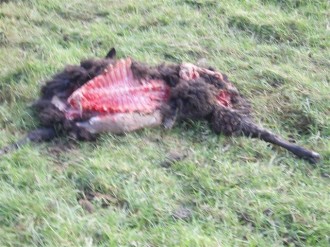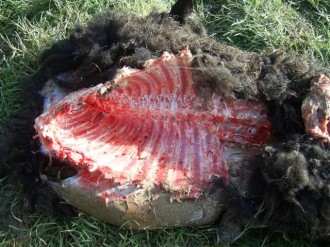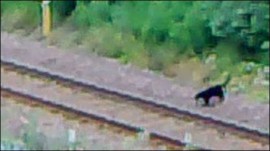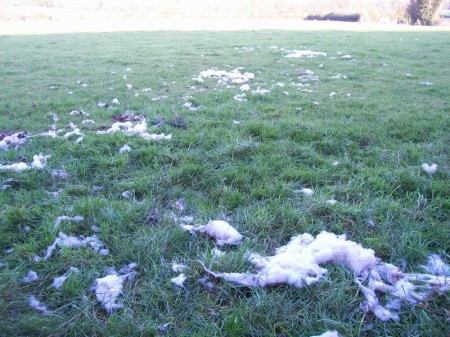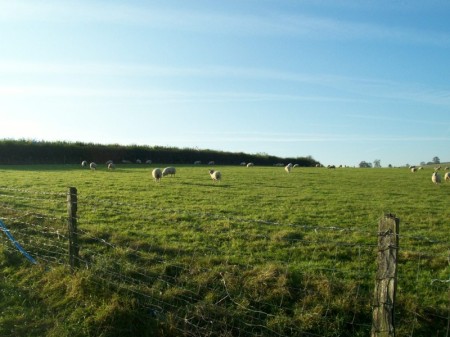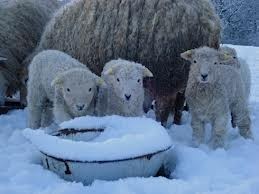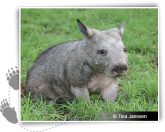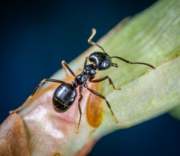
Weekend Updates: January - March 2013....
Sunday 28th, December, 2012,
Dear Visitor,
Recently, I was sent some images of possible big cat predation in Wales. Unfortunately, I have not had permission from the witness to place an overview of the recent events on their land. However, when permission is granted I will provide an overview of the reported events (including possible predation) on The Sunday Update.
What I do add though is an image of a sheep that had been possibly been predated and sent to me by another witness. Sadly the witness sent the image with no further information about location or circumstances surrounding the incident. The image is quite shocking but please note that my comments (based upon the image itself ) & with no supporting statement by the sender are purely speculative. I feel that this image is similar to predation I have encountered that I suspect is big cat and can be found in my Key Investigation Four (West Midlands). If you click on the link you can see the similarities of the carcasses. However, as I have no, 'context' for this image presented I can not speculate further.
Regards, Darrell
Sunday 6th January 2013,
Dear Visitor,
I have just received a further image of the possible big cat predation, location & context unknown, reported in my, 'What's New (The Sunday Update)' of the 28th of December 2012; see below. Again I am not able to speculate greatly on the image as no further supporting statement was sent by the witness. However, I will state that it shares many similarities with predation images I have in my Key Investigation Four (West Midlands) where I present images and assessment of the predation events of that investigation.
I will again try to gain some context of the image from the witness by email but to date they have only been happy to send images. I hope with some gentle persuasion to gain some further information. This is not uncommon to just be sent images or indeed to have full accounts rendered to me by witnesses but them not wanting details of where or when to be printed. I respect and fully understand that decision.
Regards, Darrell
Sunday 13th January 2013
Dear Visitor,
The biggest area of debate about non native big cats and big cat sightings is simply, ‘do they exist & where is the scientific evidence to support this?’ Well, first of all scientific research has to be undertaken in the first place (not just collating clippings from newspapers). From what I can gather there is very little genuine scientific research being undertaken. However, there is some scientific research that has been undertaken and if you click on this link, ‘The Evidence For The Presence of Large Exotic Cats In The Bodmin Area & Their Possible Impact on Livestock’ you will access a report by ADAS on behalf of the Ministry of Agriculture Fisheries looking scientifically at ‘big cat’ events in the Bodmin area. Also this following link will provide you with access to an ongoing research by the Countryside & Community Research Institute: 'Scientific Reasearch Into Cultural Context of Big Cat Sightings: Countryside & Community Research Institute'
These reports make very interesting reading ( I will not comment on their conclusions so as not to spoil your read of it) and shows the minimum level of scientific investigation that needs to be undertaken on all photographic and physical evidence that is in the public/private domain with regard to big cat sightings and events.
Once more there has been little on the big cat sightings front but we are getting to the time of year when reports start to come in. So I will wait and see what unfolds in the next couple of months.
Cheers, Darrell
Sunday 20th January 2013,
Dear Visitor,
Today I thought I'd take a look at one of the famous pieces of footage of a possible non-native big cat captured on video; not taken by myself (which I have posted below). What is important about this footage is that a clear ability to scale the animal is present; for at least gaining the length of the animal. The width of British railway tracks is 1.44m. If you freeze the video at various points you can see that the animals body scaled to the railway line is at least two thirds it's width so approximately 96cm. If you go to my Non-Native Big Cat Identification page you will see that an adult Melanistic Leopard body reaches a size of 1.5 - 1.8m. Could this footage be of a juvenile Melanistic Leopard? Also the length could be worked out to a greater accuracy than my aforementioned 'guestimate' if the spacing and widths of the concrete foundation beams that hold the tracks could be ascertained as the animal walks alongside the track for some time. Freeze the frame and do the math (I will aim to do that this week). What is also of note is length of the animals tail and how it holds it; I again refer you to the Melanistic Leopard on my Non-Native Big Cat Identification page (the silhouette ); the similarities are striking. Another important feature is the way the animal moves particularly when it rolls about in the grass; cat like not dog like to me. Please watch the video below several times to get a real sense of the size of this animal. Any comments please feel free to email using my Your Comments page and will add them to the website.
Sunday 27th January 2013,
Dear Visitor,
First of all I want to appologise as I did not find the time to undertake the ‘scaling’ of the possible non-native big cat (Melanistic Leopard) in last weeks Sunday Upadate (see article below) . I will try and do it this week.
Not withstanding this I want to talk this week about the issues that can be encountered when witnesses of potential big cat events get involved with the media/press. In the past few months there has been great excitement caused by the Essex Lion Sighting. Huge press coverage accompanied this sighting; which the police took most seriously and sanctioned the use of firearms for their constables. This is by no means the first time this has happened (as I know from my own investigations and Freedom of Information Requests I have made) but in past instances (the press/media involvement was limited or non-existent). The results of these other instances of firearms constables being used in a big cat sighting was that the incident was investigated, deemed as resolved (either the big cat did not exist or no evidence was found of it during the search), and then witnesses and communities quietly got on with their lives.
Now with the recent Essex Lion event the witness’s involved the press/media (which is not a criticism of them by me as I am sure they thought they were doing the right thing) and instantly a media circus developed. Now the incident is over the two witnesses have been left looking extremely foolish by many (when they thought they were only doing the right thing) and will have to deal with peoples reactions too them regarding their sighting for a long time to come. Also a community where these events have happened have been tarred with a similar brush.
My advice to anyone witnessing a big cat event is to inform the police (their wildlife liaison constable) as they need to respond accordingly to what you tell them and be very cautious about involving the media/press. They may want to know about what you have encountered and present matters in a balenced way but also remember they need to sell newspapers!!
Your comments would be more than welcome and I will be happy to publish them on the Your Comments.
Regards
Darrell
Sunday 3rd Febuary 2013,
This week I thought I'd take a closer look at a famous piece of footage of a possible non-native big cat captured on CCTV (not taken by myself) which is posted aside this text.
The photograph is taken from CCTV footage from Telford brickyard in June 1999 and purports to show a non-native big cat moving through the brickyard. Myself, I feel that the image shows a domestic cat; a large one at that. However, the issue of scale is important to my aformentioned position on the image. What is required of this footage is an investigation by photographic experts to determine the size of the animal; an organization such as Kodak using their photographic laboratories. Scale can clearly be made in reference to the animal with the bricks in the background. If the brickyard records could be found showing what type of bricks are being stored in the background or if the exact spot could be found in the brickyard where the image was captured this information could be crossed referenced with/by a photographic laboratory such as Kodak then a size for the animal could be clearly determined and thus a more accurate assessment of the type of cat could be made. Until, this research is undertaken I would have to remain of the opinion that this is a large domestic cat.
As regarding big cat sightings and events here at Big Cats GB things are quiet at the moment with just the occasional sighting being reported. Regular followers of the Sunday Update will have to be patient with regards to 'exciting’ non-native big cat sightings and events upcoming on a regular basis; it does not happen like that. Months can go by without nothing of note occurring.
As usual your comments are always welcome and I am happy to publish these on the Your Comments page on the website.
Regards, Darrell
Sunday 10th February 2013,
Sometimes things happen at the time and their relevance does not hit you until later. Today’s Sunday Update is one of those things. In the image below you will see a photograph taken from an investigation I undertook some years ago. The farm was suffering from possible big cat predation. Two areas of the farm, a mile apart, had fields with dells in them both with contained a stream. In both these dells, many sheep had been killed on a regular basis over a few years. In both locations sheep were killed in the field next to the dell then the sheep had been dragged into the dell next to the stream and devoured. I theorised that the predator used the dells for cover, struck out into the field to kill the sheep then dragged them back into the dell & the stream to eat it under the protection of cover. Then something different happened in a field between the two dells (the image below is of that predation spot in the field between the two dells). The terrain was totally different; no cover, no dell and no stream. I surmised that this may have been opportunistic predation by whatever had been killing the sheep in the dells; but the lack of water at the location baffled me; it did not fit the pattern. In the image below, of that field, you will see that the sheep had been killed at the top of the image where there is a large pile of wool and a large pile of excrement indicating the sheep had died at this location. The sheep was then dragged (you can see discarded wool heading approximately 100m to the top right of the image to the tall bush you see), then pulled over the four foot fence and then devoured. I could not understand the effort the predator had gone too to find a place to eat the sheep.
This next image is the important one though I did not realise this at the time.
As I said this image is the important one and was taken on the same day I took the first image. It was taken from the side of the fence the sheep had been dragged too and then taken over where it was devoured.
A couple of years ago I was reviewing my files on this case and had a good look at the images I had taken; then it hit me like a brick!! I worked out why the sheep carcass had been dragged so far before being devoured. If you look at mid-left of this image you will see a blue pipe that extends down into the ground and then up in the air. At the point where the blue pipe is in the air it is connected to a water trough that the sheep drink from; the blue pipe is the water pipe for this trough. Though sadly this trough is not visible in the image as at the time I did not note it’s importance.
The predator had dragged the carcass to where it had a water supply!! This makes sense; when we eat, indeed when most animals eat, we get thirsty afterwards. The same goes for predators (of whatever type). The predator killed and I suspect non-native big cat in this case (not just this predation event but all the events on the farm) then took the carcass to the only water supply for many hundreds of yards. This one off predation in this field now made more sense & fitted more accuratly the predation methods occuring on other parts of the farm.
I’d be happy to hear any other theories you may have on my theory & please feel free to use Contact Big Cats GB page & I'd be happy to place your observations on the Your Comments page.
Please see the Evidence of 'Big Cat' Predation page for more of my investigations into non-native big cat predation & events.
Regards
Darrell
Sunday 17th of Febuary 2013,
Dear Visitor,
First I must apologize to all my Twitter followers who I have Tweeted saying that the content of today's Sunday Update is about some CCTV footage of a non-native big cat walking across a pub car park. It is and it isn't!! I had intended to show CCTV footage of the animal walking across the car park and then repeating a conversation I had with the owner regarding the footage. However, as I like to get things accurate I did not want to paraphrase what the footage owner said to me and get a few things wrong. So what I have done is email the footage owner and ask them to email what they know of the footage and I will then add their observation with the footage once they have replied to me (with luck later in the week).
I'm sorry if I misled; that was not my intention but it's better to get things right than get things wrong.
Hope you all have a good week & please keep heading back to the Sunday Update this week as the footage and quote will be up here soon.
Regards, Darrell
Sunday 24th of Febuary 2013,
Dear Visitor,
I decided I would try something a little different this week and give you the Sunday Update in person; so here is my first uTube video update :-) Regards, Darrell
Sunday 3rd of March 2013,
Dear Visitor,
Below is another video Sunday Update this week asking you to send in questions that you have for me regarding the non-native big cat debate here in the UK & a rundown of all that has been going on this week at Big Cats GB. Regards, Darrell
Sunday 10th of March 2013,
Dear Visitor,
I am afraid that this weeks Sunday Update will be undertaken next week. I was going to answer peoples questions sent in this week in a vedeo. Thank you for those that have sent in questions; there are some good ones to answer several of which have been quite challenging :-) I have put the update off a week as my dad has thrown a surprise Mothers Day meal for my mum and I'm going to be attending that later today and Sunday; so I'm rushing about and don't want to do a half hearted and rushed attempt at the Sunday Update. So I will be answering your questions next week.
Regards
Darrell
Weekend of 16th/17th of March 2013,
Dear Visitor,
This week I answer your questions about the non-native big cat debate & rebut a personal attack about myself from a member of the public. Regards, Darrell
Weekend of 23rd/24th of March 2013,
Dear Visitor,
This weeks Weekend Update is looking at two newspaper articles that appeared online this week reporting events from India which I believe are of huge importance to the non-native big cat debate here in the you UK. To paraphrase the two articles, links to which are at the bottom of the Weekend Update, it appears that large numbers of Leopards have been proven to be living extremely close to human populations in India; with no attacks on humans being reported. I quote directly from the articles now:
The study was conducted in a densely populated valley in Akole tehsil of Ahmednagar district in western Maharashtra, where researchers set up camera traps in 40 locations for a month to gather evidence of wildlife in this prosperous sugarcane belt. The results were startling. A total of 81 leopard images were captured across a sampled area of 179 sq km, in which five distinct adult males and six adult females were identified.Two females were clicked with cubs and a third gave birth six months later
all in an area with a population density of 357 people per square km.
This section of the article below is the most interesting bit for today's update. Please note that the aforementioned & following information has been gained in India by Leopards being tracked with electronic tags they have been fitted with:
The big cat's density in Akole tehsil was found to be higher than some national parks. In Rajaji, for instance, distribution of leopards is reported to be just 2.07/100 sq km following an increase in tiger numbers. Overall, leopard density in India's protected forests is 15/100 sq km...Athreya said with the nearest protected forest some 18km away, there was little doubt that the big cats were living in "human areas", mainly in sugarcane fields. "The leopards were marking their territories on roads and on bunds in sugarcane fields. This was as much their land as it was of the people," she said.
During daytime, the felines would sit very still in the fields, often just a few hundred metres from houses. "However, the night made the leopard king. They even went close to houses to kill dogs, cats and goats," Athreya reported. Remarkably, no human deaths were reported from the study area. Athreya believes this is so because the leopard population in the area is more or less settled. "Leopards instinctively shun humans. That's particularly true of an animal that has grown up in the same area. We found one of our radio-collared leopards visited a particular house every few days without ever disturbing its residents, who sleep in the open," she said.
No how is this relevant to non-native big cats in the UK? Well, the majority of sightings reported are of Melanistic Leopards (and lets for arguments sake assume that they exist in the UK). There are (to my knowledge) no credible reports of attacks on people in the UK and certainly no deaths. This creates a picture of the UK (Leopards living close to human populations) similar to this research from India where LEOPARDS DO INDEED EXIST!! The researcher states;
'Remarkably, no human deaths were reported from the study area. Athreya believes this is so because the leopard population in the area is more or less settled. "Leopards instinctively shun humans. That's particularly true of an animal that has grown up in the same area....'
So if the UK Melanistic Leopard echoes the behaviors of Indian Leopards and if there is a Melanistic Leopard population in the UK it must be a settled one (that has been here for many years and have been breeding) as there have been no UK attacks on humans. However, it may also mean that as there have been no attacks on humans in the UK there may be no Melanistic Leopards on the loose!!!!
I find these articles absolutely fascinating for their ramifications for the non-native big cat debate here in the UK. I hope you read the links below to both articles as they are a great read by true experts in the field not amateur investigators like myself. Your comments as usual are always welcome.
Have a great weekend; Darrell (Big Cats GB)
Weekend of 30th/31st of March 2013,
Dear Visitor,
This weekends update is primarily going to focus on the plight of sheep farmers in this devastating cold spell. I'm focusing on them as without their support over the years none of what I do would be possible. Monthly I call farmers to find out what's going on on their farms with relation to non-native big cats. Their responses this week have all been the same, 'the weather is decimating their livestock and threatening many of their livelihoods'. Non-native big cats are the last thing on their mind at the moment.
This is best summed up by one farmer who explained, and I now paraphrase what he had to say to me; his ewes have stopped producing milk for the lambs as they are unable to get sufficient nourishment from grass and the extra man made feed he is providing them. He explains that his ewes shut down milk production if they can not get enough nutrition inside them. Thus the lambs are having to be reared by hand and some have started eating grass at a stage in their development when they should be being weaned by the ewes. He does not know if wholesale nutritional providers are cutting corners trying to save money and the food they provide is not as nourishing for the ewes as it once was. He has ordered thousands of pounds worth of extra nutritional supplements for his ewes but they still are not producing enough milk. He says that if the weather turns wet his lamb deaths will sky rocket from their already high percentage he is facing at the moment. He says things are desperate.
I know myself that farmers care about their stock and are doing all they can to raise their lambs in the best way they can. This year, due to the weather, is for many going to take them to the edge of their endurance and their livelihood's may be threatened. Lets all hope the cold snap brakes and wet weather holds off. I add a couple of links below showing articles relating the difficulties they are facing.
Please note that the two reports picked from the internet at random do not come from farmers I know and to the best of my knowledge do not have non-native big cat predation on their land.
http://www.bbc.co.uk/news/uk-england-shropshire-21928186
In relation to non-native big cat events this week nothing has been reported to me but to be frank my mind is elsewhere; with the farmers who's support makes my hobby possible.
Regards, Darrell










